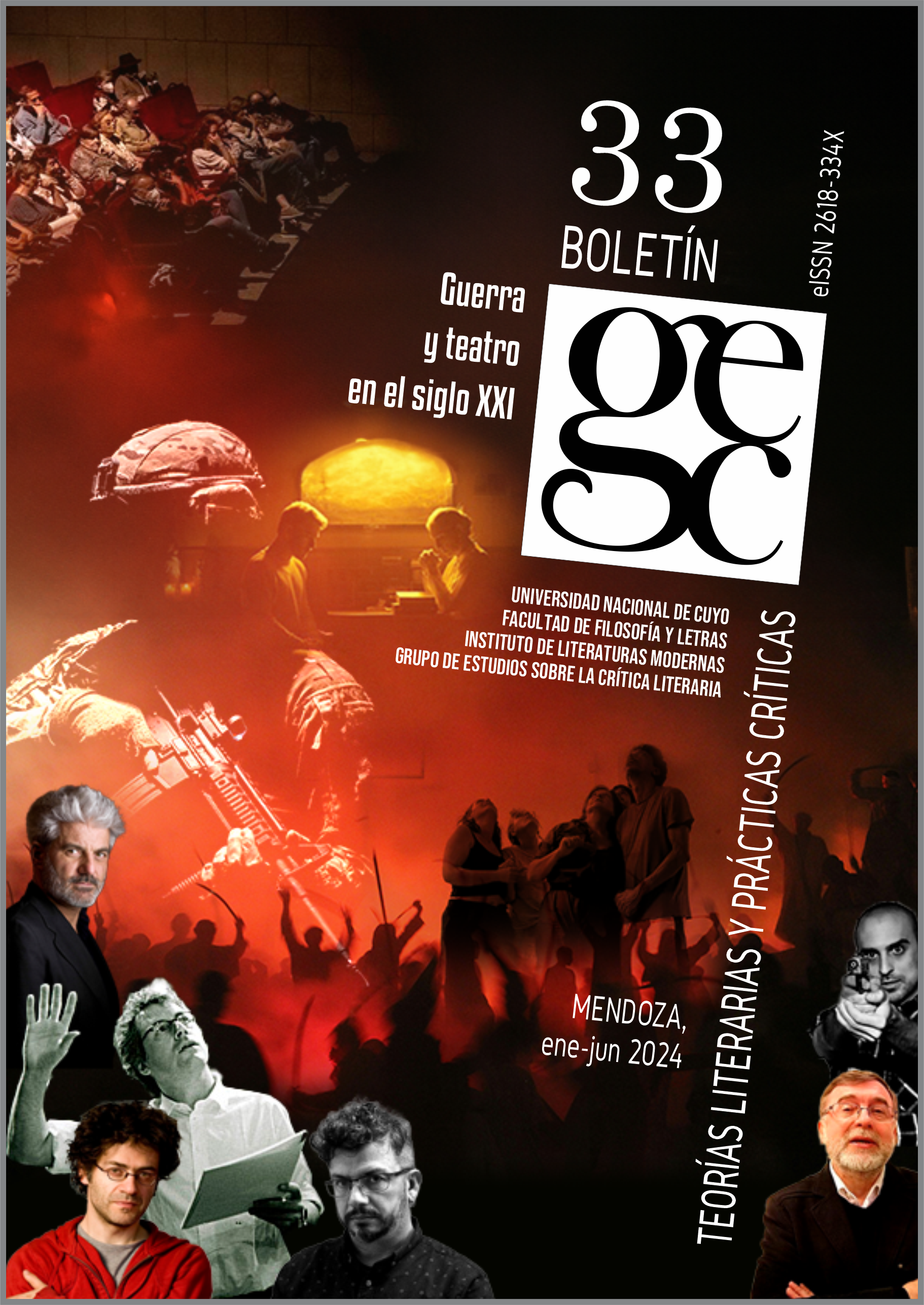Migratory griefs as objects of representations: Untold wars
DOI:
https://doi.org/10.48162/rev.43.055Keywords:
Colombian dramaturgies, migration, war, migratory grief, theatreAbstract
The current migratory phenomenon leads to various problems that not only concern the people who must migrate, but can involve a whole country and go beyond it to become a global phenomenon. In this article, we want to approach the dramaturgical texts Pies morenos sobre piedras de sal by Ana María Vallejo, Mapa by Amaranta Osorio and Silencios by Camilo Vergara to analyze how the migratory processes are represented within some Colombian dramaturgies, delving into those poetic images that produce intimate and collective spaces in the characters, and with them the motives of migration, the journeys and the transformations that their protagonists undergo, to unveil through this interpretative analysis new forms of writing in Colombian theater, which bring and allow us to understand some approaches to the phenomenon of migration that, as a society, we are currently experiencing.
References
Achotegui, J. (2008). Duelo migratorio extremo: el síndrome del inmigrante con estrés crónico o múltiple (Síndrome de Ulises). Revista de psicopatología y salud mental del niño y del adolescente, (11), 15-25. https://www.fundacioorienta.com/es/revista-11/
Achotegui, J. (2012). Emigrar hoy en situaciones extremas. El síndrome de Ulises. Aloma. Revista de Psicologia, Ciències de l’Educació i de l’Esport, 30(2), 79-86. https://raco.cat/index.php/Aloma/article/view/263043
Achotegui, J. (2022). Los siete duelos de la migración y la interculturalidad. NED Ediciones.
Arango, J. (2000, septiembre). Enfoques conceptuales y teóricos para explicar la migración. Revista Internacional de Ciencias Sociales de Paraguay, (165), 33-47. https://unesdoc.unesco.org/ark:/48223/pf0000123859_spa
Bauman, Z. (2005). Vidas desperdiciadas: La modernidad y sus parias. Paidós.
Bhabha, H. (2018). El entre-medio de la cultura. En S. Hall y P. Du Gay (Coord.), Cuestiones de identidad cultural (pp. 94-106). Amorrortu.
Butler, J. (2006). Vida precaria: El poder del duelo y la violencia. Paidós.
Camacho, S. (2014). Poéticas del desarraigo: El cuerpo y la palabra en las dramaturgias colombianas femeninas contemporáneas. IDARTES.
Centro Nacional de Memoria Histórica (2010). La masacre de Bahía Portete: Mujeres Wayúu en la mira. Taurus.
González Rivera, J. (2018, 4 de marzo). La diáspora intelectual venezolana. Revista Semana, 84-86.
Instituto de Estudios para el Desarrollo y la Paz (2023, 20 de abril). Cifras de la violencia en Colombia. INDEPAZ. https://indepaz.org.co/cifras-de-la-violencia-en-colombia/
Mardones, P. (2005). Aportes de la antropología para el análisis de las migraciones internacionales. VI Reunión de Antropología del MERCOSUR (RAM). Montevideo, Uruguay. Recuperado el 2 de septiembre de 2023. http://bibliotecavirtual.clacso.org.ar/ar/libros/becas/2005/2005/migra/mardones.pdf
Morales, G. (2018). De la necesidad y la esperanza. En C. Fernández Soto et al., Sillas en la frontera: Mujer, teatro y migraciones (pp. 295-304). Universidad de Almería.
Münkler, H. (2005). Viejas y nuevas guerras: Asimetría y privatización de la violencia (Trad. C. Martín). Siglo XXI.
Ortega Garzón, S. M. (2020). De hombres y de bestias: Figuras animales de lo político en el teatro colombiano. Editorial UD.
Ortega Garzón, S. M. (2021). Del paraíso al matadero: Representaciones afectivas hacia “el campo” en la dramaturgia colombiana contemporánea. En M. Ramírez, E. Cortés, M. Ramos, M. Travieso y S. M. Ortega Garzón, Imaginarios del arte y la estética (pp. 88-99). RED IBAI.
Osorio, A. (2023). Mapa. Ediciones Invasoras.
Rodríguez Quiñones, D. (2010). La migración de retorno en Colombia: Un fenómeno por comprender. [Tesis de grado, Pontificia Universidad Javeriana de Bogotá]. Repositorio Institucional Javeriano. http://hdl.handle.net/10554/7744
Ruiz Ruiz, N. Y. (2021, 3 de noviembre). La migración en Colombia en el tapón del Darién y la violencia que desata sobre la población. Periódico de la Universidad Nacional de Colombia. https://periodico.unal.edu.co/articulos/la-migracion-en-colombia-en-el-tapon-del-darien-y-la-violencia-que-desata-sobre-la-poblacion/
Sayad, A. (2010). La doble ausencia: De las ilusiones del emigrado a los padecimientos del inmigrado. Antropos.
Segato, R. (2014). Las nuevas formas de la guerra y el cuerpo de las mujeres. Revista Sociedade e Estado, 29(2), 341-371. https://periodicos.unb.br/index.php/sociedade/article/view/5889
Suárez, A. (2017, 4 de marzo). Más allá de México, 70 “muros” separan al mundo en pleno siglo XXI. El Tiempo. Recuperado el 2 de septiembre de 2023. https://www.eltiempo.com/mundo/eeuu-y-canada/muros-como-el-de-trump-que-separan-fronteras-del-mundo-64224
Vallejo, A. M. (Autora) y Valdez, F. (Músico) (introducción de Jambrina, N. y Serban, G.). (2018). Pies morenos sobre piedras de sal. Pieds nus sur les pierres de sel. Presses Universitaires du Midi / Université de Toulouse Jean Jaurès.
Vallejo, A. M. (2021). Teatralidades del viaje. Ojo al arte, (15), 10-16. https://unibac.edu.co/webnueva/wp-content/uploads/2021/12/OJO-AL-ARTE-15.-2-3.pdf
Vergara, C. (2020). Silencios. Ministerio de Cultura de Colombia.
Yates, C. y Pappier, J. (2023). Cómo el peligroso Tapón del Darién se convirtió en la encrucijada migratoria de las Américas. MPI. Migration Policy Institute. https://www.migrationpolicy.org/article/tapon-darien-encrucijada-migratoria-americas
Downloads
Published
How to Cite
Issue
Section
License
Copyright (c) 2024 Sandra María Ortega Garzón, Sandra Camacho López

This work is licensed under a Creative Commons Attribution-NonCommercial-NoDerivatives 4.0 International License.
Aquellos autores/as que tengan publicaciones en esta revista, aceptan los términos siguientes:
- Los autores/as conservarán sus derechos de autor y garantizarán a la revista el derecho de primera publicación de su obra, el cual estará simultáneamente sujeto a la Licencia de reconocimiento de Creative Commons que permite a terceros compartir la obra siempre que no se use para fines comerciales, siempre que se indique su autor y su primera publicación en esta revista, y siempre que se mencionen la existencia y las especificaciones de esta licencia de uso.
- Los autores/as podrán adoptar otros acuerdos de licencia no exclusiva de distribución de la versión de la obra publicada (p. ej.: depositarla en un archivo telemático institucional o publicarla en un volumen monográfico) siempre que se indique la publicación inicial en esta revista y se cumplan las otras condiciones mencionadas arriba.
- Se permite y recomienda a los autores/as difundir su obra a través de Internet (p. ej.: en archivos telemáticos institucionales o en su página web) antes y durante el proceso de envío, lo cual puede producir intercambios interesantes y aumentar las citas de la obra publicada. (Véase El efecto del acceso abierto).








